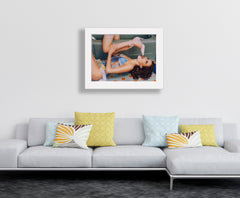
David LaChapelle - Artworks for Sale

David LaChapelle: A Visionary Lens on the Human Experience
David LaChapelle was born on March 11, 1963, in Hartford, Connecticut, a city that, while unassuming, planted the seeds for his boundless imagination. The middle child of three, LaChapelle grew up in a working-class family, his father a factory worker and his mother a nurse with a penchant for staging elaborate family photoshoots. These early forays into staged imagery, coupled with his fascination with glossy magazines pilfered from his mother’s bedside table, ignited a lifelong obsession with the interplay of beauty, excess, and narrative.
As a teenager, LaChapelle found solace in art, sketching feverishly and experimenting with his mother’s Polaroid camera. At 15, he left home for New York City’s Lower East Side, a gritty haven for misfits and creatives in the late 1970s. There, he immersed himself in the pulsating nightlife of Studio 54 and the raw energy of the East Village art scene, rubbing elbows with the likes of Keith Haring and Jean-Michel Basquiat. It was Andy Warhol, however, who became his north star. At 17, LaChapelle landed a job at Warhol’s *Interview* magazine, initially as a gofer but soon as a photographer, mentored by the Pop Art icon himself. Warhol’s philosophy—that everything, from soup cans to superstars, could be art—shaped LaChapelle’s approach to collapsing the boundaries between high and low culture.
By the late 1980s, LaChapelle’s hyper-saturated, surrealist style began to take form. His photographs, drenched in candy-colored palettes and teeming with subversive wit, challenged the era’s minimalist aesthetic. He didn’t just shoot portraits; he built worlds—baroque, fantastical sets where consumerism, religion, and sexuality collided. His 1995 series *After the Deluge* reimagined biblical flood narratives as a critique of materialism, with models posing amid submerged luxury goods. Critics were divided: some hailed him as a visionary, others dismissed his work as garish spectacle. LaChapelle, unfazed, leaned into the controversy, insisting that art should provoke as much as it seduces.
The 1990s and early 2000s saw LaChapelle at the zenith of commercial success. He shot iconic campaigns for brands like Diesel and Tommy Hilfiger, directed music videos for artists like Britney Spears and Elton John, and became a fixture in fashion editorials for *Vogue* and *Vanity Fair*. His 1999 image of Lil’ Kim, her body adorned with diamond-encrusted logos, became a cultural touchstone, blending high fashion with street swagger. Yet, beneath the glitz, LaChapelle’s work carried a biting edge—his 2003 series *Jesus Is My Homeboy* recast Christ as a modern-day everyman surrounded by urban archetypes, challenging religious dogma and societal norms.
By 2006, at the height of his fame, LaChapelle abruptly retreated from the commercial world, overwhelmed by its relentless pace and what he called “the commodification of creativity.” He relocated to a farm in Maui, Hawaii, where he lived off the grid, growing avocados and rediscovering photography as a personal pursuit. This period birthed his 2010 series *The Raft*, inspired by Géricault’s *Raft of the Medusa*, a meditation on human fragility in an era of ecological and social collapse. The works, exhibited at the Museum of Modern Art in New York, marked his return to fine art and silenced doubters who questioned his depth.
LaChapelle’s later career cemented his status as a cultural prophet. His 2017 series *New World* tackled themes of spirituality and technology, envisioning a utopia where humanity reconciles with nature. His exhibitions, from Paris’s Palais de Tokyo to Seoul’s Museum of Contemporary Art, drew record crowds, proving his relevance in a digital age. A vocal advocate for mental health and environmental causes, LaChapelle also founded the Peace Studio, a nonprofit mentoring young artists in underserved communities.
Today, at 62, LaChapelle remains a restless innovator. His recent experiments with AI-generated imagery and immersive installations push the boundaries of photography, yet his core mission endures: to mirror society’s excesses and aspirations with unflinching honesty. Married to his longtime partner, choreographer Damien Jalet, LaChapelle splits his time between Los Angeles and Maui, ever the alchemist turning the mundane into the sublime. As he once said, “I don’t photograph the world as it is—I photograph it as I want it to be.” Through his lens, that world is gloriously, unapologetically alive.
Get David LaChapelle Alerts First
Subscribe to our newsletter to get an instant alert when we add the next piece by David LaChapelle
| Current David LaChapelle Inventory | Recent David LaChapelle Sales |

